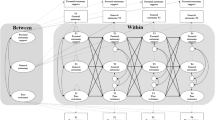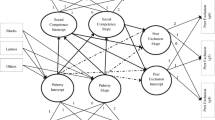Abstract
This research examines the effects of specific physical changes associated with puberty on peer and parent relationships of early and middle adolescent white boys. The data used are from a longitudinal study of Milwaukee school children conducted by Simmons and Blyth (1979). On the basis of past research, most of the physical changes that occur during puberty were expected to increase peer status. According to Richer's (1968) exchange model, these positive effects in the domain of peer relations should, in turn, reduce the resource dependency of the adolescent on his parents. As a result, greater independence from parents should ensue and the likelihood of conflict should increase. As expected, significant positive relationships were found for the effects of various physical changes on most peer status variables and independence from parents. However, no significant relationships were found for the effects of physical changes on parent-adolescent relationship quality or conflict with parents. Also contrary to expectations, controlling for changes in peer status did not alter the positive effects of physical change on independence from parents. Finally, tests for interactions showed that the parent-adolescent relationship was negatively affected when parents did not grant greater independence to the physically changing adolescent. In conclusion, it is suggested that while resource dependencies may indeed change during puberty, parents alter their expectations for their children and grant greater independence based on the adolescent's physical appearance alone.
Similar content being viewed by others
References
Bock, R. D. (1975).Mullivariale Statistical Methods in Behavioral Research. McGraw Hill, New York.
Bulcroft, R. A. (1989). The value of physical changes during adolescence: Consequences for peer and family relations. Unpublished doctoral thesis, University of Minnesota.
Carlton-Ford, S., Simmons, R., and Blyth, D. (1983). Analyzing longitudinal data from quasiexperimental designs: The analysis of change. Paper presented at the annual meeting of the American Sociological Association, Detroit, MI.
Carmines, E. G., and Zeller, R. A. (1979).Reliability and Validity Assessment. Sage, Beverly Hills, CA.
Clausen, J. A. (1975). The social meaning of differential physical and sexual maturation. In Dragastin, S. E., and Elder, G. H. (eds.),Adolescence in the Life Cycle: Psychological Change and Social Context. Wiley, New York.
Edwards, J. N., and Brauburger, M. B. (1973). Exchange and parent-youth conflict.J. Marriage Family 35: 101–107.
Jacob, T. (1974). Patterns of family conflict and dominance as a function of child age and social class.Develop. Psychol. 10: 1–12.
Jones, M. C. (1965). Psychological correlates of somatic development.Child Develop. 36: 899–911.
Jones, M. C., and Bayley, N. (1950). Physical maturing among boys as related to behavior.J. Educat. Psychol. 41: 129–148.
Kerlinger, F. N., and Pedhazur, E. J. (1973).Multiple Regression in Behavioral Research. Holt, Rinehart and Winston, New York.
Latham, A. J. (1951). The relationship between pubertal status and leadership in junior high school boys.J. Genet. Psychol. 78: 185–194.
Mussen, P., and Bouterline-Young, H. (1964). Relationships between rate of physical maturing and personality among boys of Italian decent.Vita Humana 7: 186–200.
Offer, D., Ostrov, E., and Howard, K. I. (1981).The Adolescent: A Psychological Self-Portrait. Basic Books, New York.
Richer, S. (1968). The economics of child-rearing.J. Marriage Family 30: 462–466.
Rutter, M., Graham, P., Chadwick, O., and Yule, W. (1976). Adolescent turmoil: Fact or fiction?”Child Psychol. Psychiatr. 17: 35–56.
Savin-Williams, R. C. (1976). An ethological study of dominance formation and maintenance in a group of human adolescents.Child Develop. 47: 972–979.
Savin-Williams, R. C. (1979). Dominance hierarchies in groups of early adolescent males.J. Youth Adolesc. 50: 923–935.
Silverberg, S. B., and Steinberg, L. (1987). Adolescent autonomy, parent-adolescent conflict, and parental well-being.J. Youth Adolesc. 16: 293–312.
Simmons, R. G., and Blyth, D. A. (1987).Moving into Adolescence: The Impact of Pubertal Change and School Context. Aldine DeGruyter, New York.
Smith, T. E. (1976). Push versus pull: Intra-family versus peer-group variables as possible determinants of adolescent orientations toward parents.Youth Society 8: 5–26.
Steinberg, L. D. (1981). Transformation in family relations at puberty.Develop. Psychol. 17: 833–840.
Steinberg, L. D., and Hill, J. (1978). Patterns of family interaction as a function of age, the onset of puberty, and formal thinking.Develop. Psychol. 14: 683–684.
Susman, E. J., Nottelmann, E. D., Inoff-Germain, G. E., Dorn, L. D., Cutter, G. B., Loriaux, D. L., and Chronsos, G. P. (1985). The relation of relative hormonal levels and physical development and socio-emotional behavior in young adolescents.J. Youth Adolesc. 14: 245–264.
Author information
Authors and Affiliations
Additional information
The author has a Ph.D. in sociology from the University of Minnesota. He is currently analyzing data from the recently completed National Survey of Families and Households on dating and remarriage in later life. He is also continuing his analysis on the data set used here to explore changes in the factor structure of orientations to parents and peers as a result of pubertal and other early adolescent transitions.
Rights and permissions
About this article
Cite this article
Bulcroft, R.A. The value of physical change in adolescence: Consequences for the parent-adolescent exchange relationship. J Youth Adolescence 20, 89–105 (1991). https://doi.org/10.1007/BF01537353
Received:
Accepted:
Issue Date:
DOI: https://doi.org/10.1007/BF01537353




